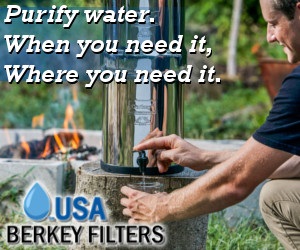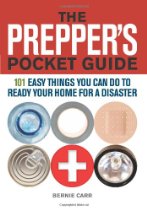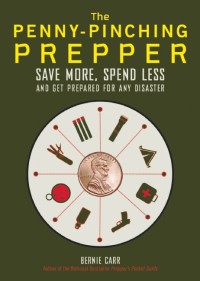This post is by Bernie Carr, apartmentprepper.com
I thought it might be a good exercise to try doing laundry without using the washing machine and dryer. Whenever there is a hurricane approaching one of the preparation chores that I do (in addition to making sure there is enough water, food and supplies for several days) is to do the laundry while power is available. Ideally, you’d already have clean clothes available, but what if there is an extended power outage?
I saved a few pieces of clothing, some socks and a large towel to do the experiment.
Washing
I piled the clothes in the bathroom sink. For clothes washing, I tried using a Mobile Washer sample that I received.. It was easy to assemble. The washer looks like a plunger, but without the rubbery plunger smell.
The instructions simply say add soap and 4-6 inches of water and agitate the clothes using up and down motion. I used my homemade laundry detergent added to some water.
 The socks were stained but I did not use bleach, as I wanted to keep the experiment as simple as possible.
The socks were stained but I did not use bleach, as I wanted to keep the experiment as simple as possible.
Although the Mobile Washer instructions say you will feel a pulling action while the clothes are agitating, I did not really feel that the up and down motion was doing anything. Perhaps the clothes had to be level to the ground or bathtub for this to work, as using it on a bathroom sink level felt unwieldy to me. I wish I had a better result to report to you, but I always write the truth in these experiments regardless of expectations.
I contacted Mobile Washer after the experiment about my less than stellar results and got a quick response, which actually addresses what happened:
“The best way to get this action on the clothes is to make sure you have enough water so the clothes float freely, have a deep enough container (sink, bucket, tub etc) so that you can get some good plunging action without splashing the water out of the container. When these steps are followed, the washer seems to have great results. I can’t say that you were doing it wrong, maybe it just required a little harder agitation.This is actually the first negative feedback we have received, so I do appreciate you letting me try to explain how it should work and what results you should be able to expect. Normally the feedback is that the washer has pulled old stains and residual dirt and soap left behind by traditional washing machines. “
I think the Directions for Use should mention the container should be deep enough for enough water so the clothes can float around. The “4-6 inches of water” was quickly soaked up by the clothes. The next time I wash off-grid, I will use a 5-gallon bucket.
Back to the story… I resorted to washing the items by hand. My hands did get all wrinkled and “prune-like” so if I do this again I would wear gloves.
After washing, I let the soapy water drain out. I then rinsed the clothes with plain water in the sink. The interesting part was in trying to wring all the water out. Socks and shirts are easy enough, but the towel was quite heavy. I had to wring it out in sections.
Drying
I found some space to hang the clothes using hangers and some of the shelving. Because of the humidity, the socks and shirts took about 12 hours to dry, and the towel took over 24 hours.
Result
T-shirts and blouses dried well enough with minor wrinkles when hung up in clothes hangers. The clothes and socks smelled fresh and appeared to be clean enough. The socks did not come out as white as when bleached and washed in the washing machine.
However the towel took a very long time to dry, causing even more humidity with a slightly musty smell when it finally dried.
What I Learned
Living in a humid climate, if clothes stay wet long enough, there is a possibility of getting mildew, so you must try to wring out the clothes as well as possible.
If you live in a dry climate, the drying time would be a lot faster.
Having a clothesline outside would be much better than drying indoors as the hot sun would help dry things faster. However because we rent, I doubt apartment management would look too kindly to having clothes flapping in the breeze out in the balcony. So if I had to line dry, I would likely set the line across the bathroom.
Line dried clothes do not come out as soft as they do in the dryer. On the other hand, this saves on wear and tear on the garments.
To minimize wrinkles, you need to “snap”clothes such as t-shirt and shirts before hanging them.
If you had to do laundry off-grid, you’d best have some backup clothes available to allow for longer drying time.
No doubt about it, washing and drying clothes are chores that would be much more challenging without electricity. It is doable, and I am glad I tried this experiment.
© Apartment Prepper 2013















I read on another blog that you can use two buckets for wringing. Apparently, the bottom larger bucket has holes, and the smaller two bucket does not. Put in clothes, top with smaller bucket, and press. I haven’t tried it yet, but it would be easier than wringing, especially if you have carpal tunnel or arthritis.
Some people use the mobile washer in a bucket with a hole in the lid for the handle. Churn like butter.
I haven’t tried either, but this is what I’ve heard.
My Wonder Washer is assembled to be tried this week.
I bought a washboard, bought in a little town, and an industrial mop wringer from Walmart.
Of course I have two tubs from TSC and two plungers.
Oh, my Mom had a drying rack when we lived in apartments. They work nicely. Amazon and any hardware store should have them.
Sorry. Last idea on wringing and drying. Put wet clothes in towel, roll, and walk on it it. This does work very well. I promise I am done. 🙂
Hi Linda, That is a good idea, rolling the clothes in a towel. Don’t be sorry-your comments are appreciated!
Wringing really is the worst part, which is why our grandparents had wringer attachments on their laundry tubs. 🙂 I would think it shouldn’t be too difficult to find an old wringer attachment, or even to create one. Thanks for the review of this, though!
RevAllyson, That wringing IS definitely the hard part. One of those wringers would be great to have.
What I do is, I use one rolling pin on the clothing, just like rolling pastry dough. I roll on a tilted piece of heavy plastic sheeting, down into the sink.
There might well be misplaced insouciance in this thread:
<>
Really? Why would your bathroom be warm at all if the grid driving its central heating has gone down at SHTF? Do you have warmth in there that is not power-based? Or would you set a propane/kerosene/wood heater in there?
In Europe, some apartment blocks have a shared tenants’ attic for drying: hot air, if any, rises. Others have drying rooms in the basement.
In the USA, as far as I know, only Lehmans sell manual wringers, also to the Amish. One has good reviews, the other not.
Another point: there is no mention of handling diapers for babies or the incontinent old.
At SHTF there will be no more disposable diapers for lack of power to the factories and storing them in bulk in an apartment pre-SHTF for a baby is very space-consuming and there will be no trash pickup at SHTF anyway and they compost very slowly if at all, in your landlord’s garden (?!).
So practise how to wash and dry cloth diapers using anti-bacterial commercial liquids or bleach.
Let us hope this
https://www.dellchallenge.org/projects/giradora-safe-agua
goes into production soon, because I do not fancy washing clothes by hand for 6 hours per day like the slum women above Lima.
Diaper, We are in Texas where it is hot and humid for several months. Beginning in April through late October, the heat and humidity is a constant. A manual wringer would be great to have. Thanks for the comment.
I have dried clothes at night–yes, put them on my line on the covered porch at 11.
Dry next morning at 7. 🙂
You mentioned AMISH laundry wringers in your article. I’ve tried to find one but came up luckless. Do you happen to know where they can be purchased?
Thanks,
Tom
Hi Tom, I haven’t personally tried them, but Lehman’s https://www.lehmans.com/default.aspx carries laundry wringers. (I heard about their services from The Self Sufficient Homestead podcast.)
When I was in the military, we had to wash our clothes in the field by hand. We used a deep bucket and pushed them up and down in the soapy water to get them as clean as possible, then rinse well. To wring them out, it works best if two people take them and twist in opposite directions. One person just can not wring out a heavy towel very well. You will have to face the fact that clothes will not be as clean as they use to be when we are off grid. We used to also soak our really dirty clothes to help loosen the dirt.
Hi JAS, Good to here from someone who has done this on a regular basis. Thanks for the comment!
I’ve often thought about getting one of those mop wringers that fit over a bucket to see if that would help during a grid down situation. We also use to use a folding wooden clothes rack to hang clothes on in front of the wood stove when I lived up north. You could sit it out on the balcony or even in the yard if you had too.
Well, I have a mop wringer bucket which I bought to try out as you are suggesting.
But:
1. the capacity of the compartment for the mop head where you put the wet clothes before squeezing them with a handle that drives a holed plate to squash water out so it can run down into the bucket is quite small. That is, I cannot fit the 2.5 kg contents from my Wonder Wash manual washer (mentioned by another person this thread) into that compartment.
2. I do not think from my results of squashing the clothes that the pressure exerted by the plate is anywhere near the pressure exerted by the manual wringers on pre-1960s semi-automatic washing machines, or by the current manual wringer models sold by Lehmans in USA. That is, not enough water gets wrung out compared to what happened to the wet cotton sheets my mother used to process through the semi-automatic’s manual wringer.
However, I do use this mop-bucket method to get initial water out of a wet cotton towel or cotton jeans full of water because the manual wrist-twisting you otherwise have to use is an intense effort, given the amount of water and thus time involved. That effort will damage wrists and elbows over time at SHTF.
So on balance, I am happy I have the bucket especially as mopping floors after SHTF becomes vital for hygiene.
I bought a leather welder’s apron and treated it with water repellant. In that way, I have a fire-resistant dirt cover to wear at SHTF which will hopefully restrict the need for washing clothes to mainly underwear/sox only, because my outerwear will remain cleaner.
Hey Diaper – Great evaluation of the mop wringer bucket. It sounds like it’ll work short-term but good for cleaning in the long run. That manual wringer from Lehman’s may be the one to have. Thanks for sharing your findings-this helps all of us.
Don’t you expect clean clothes will get a new meaning??
I wear the same mowing and painting clothes now–WTSHTF, I will wear most clothes many days..ya think??
And those teens using 3 towels every day are in for a reality check??
Hi Jayjay, I bet win a SHTF scenario clothes would be worn over and over; we wouldn’t be as fastidious about washing clothes right away. Thanks for the comments!
when my husband and i first got together we had a water leak and i was using some dirty towels to soak up the 4 in of water in the laundry room and he had a wringer mop bucket (like you see in commercial use everywhere a.k.a. yellow ones) and it worked well for wringing out the water and i could get 2 lg towels in at a time and 3 smaller ones .. and they worked well. as to the comment about it not holding your whole load it would be more effective to wring them in smaller batches anyway .. i have 2 buckets set aside in the garage for off grid washing if needed one for was and one for rinse and the wringer is next to that in case of emergency i have 4 outfits and 6 socks and under things packed that way if it takes a while for them to dry you can reasonably have a back up supply of clothes if you wash clothes daily its not a lot of washing and you should always have dry clothes …when shtf i would hang my clothes on the balcony even in winter they will dry you may have to bring them in to warm them. anyway sorry it was such a long response
Hi Melissa, I will be doing that – keeping 2 buckets set aside in the garage just for offgrid laundry. Nothing to be sorry about- I appreciate the comments! Thanks!
Just to add to JAS’s comments. Teamwork is the best method when wringing out your clothes. Experiment with your soap as something that works at home may not work in the field (I reacted to some “camping soaps”). I found an Amway liquid soap that required very little to use and rinsed off with no problems. Once when we deployed to an area overseas following an earthquake we were set up in a village. Even with our tents inside a compound surrounded with a barbwire fence the locals still found a way to “borrow” our socks and underwear that we had hung to dry by our tents. One more security item to think about 🙂
Hi JG, I think I had heard about that Amway product ages ago, It was a bit expensive but it sounds like a good one to have for an emergency. Sheesh, I’d never even think of anyone taking used socks and underwear drying outside but in a grid down situation, or extremely poor conditions, that can happen. Thanks for the comment
If you can add it to your budget, I would recommend a manual wringer. I have one from Lehman’s. My family goes semi off grid camping for 2 weeks over the summer. I have a Wonder Washer and the wringer we take for limited laundry. They work nicely. And the kids love to run the wringer. So much water is removed with the wringers and things do dry so much faster.
Hi Jen- wow, that manual wringer from Lehman’s seems to have a lot of positive feedback. We’ve never gone camping over a week-2 weeks would definitely need a way to wash clothes. Thanks for mentioning the camping benefit.
Warning concerning the wringers sold but not made by Lehman’s:
last time I looked at the website, the firm was selling two different manual wringers. One got a very bad and detailed customer review in spite of looking just fine in the photo, the other did not.
Consider also where you will attach the wringer so that using it does not stress you: you may need to buy a wash tub that is high enough off the ground for you not to have to kneel down to crank the wringer handle, which is what you have to do if you just clamp such a wringer to the lip of a standard bathtub.
The drying rack is a good idea. If you have a deck then this is the place to put them. I use a 12 gallon bucket with a screw on lid and a plunger. The bucket had granular calcium hypochrolite in it, outdoor pool chlorine sometimes called HTH. A commercial outdoor pool (YMCA, resort, etc) may let you have empty buckets. I wash in one, rinse in another then wring the clothes with a lever type mop wringer. Rubbermaid commercial brand available at Home Depot. Usually used in commerical cleaning operations. The wringer get out a great amount on water but you must press hard, just lean on the handle.
Hi Joseph, Good idea, setting up drying rack in the deck. The 12 gallon bucket would be ideal, instead of the 5-gallon. Thanks for the tip!
use a clothes rack and a box fan to speed up air drying
Hi John, A fan would be a good way to speed up drying-thanks!
For towels, twist one direction, then fold in half and twist the other way. For longer objects, fold in half again and go back the first direction again. I’ve done laundry by hand more times than I’d like to count.
Hi Heather, That wringing idea is great-good to hear from someone who has a lot of experience in this.
also consider changing the towels you use: we’ve used thinner 50/50 cotton/poly towels when camping or in countries where laundry is done by hand. easier to wring out and usually dry overnight. if on the grid, use a fan to circulate air around laundry or consider “ironing them dry” if mold/mildew is a concern. hot work, but if you’re allergic to mold it’s worth it.
underwear tip: hang them on the line by one side of waistband & crotch instead of by both sides of waistband. lowest part of hanging laundry will stay damp the longest — if you have to wear a not-quite-dry pair of undies off the line having the damp spot on one hip isn’t so bad.
Hi Amy, Thanks for the great advice, lighter towels would dry a lot quickly. Sounds like you’ve washed a lot of laundry off grid! I appreciate the comment.